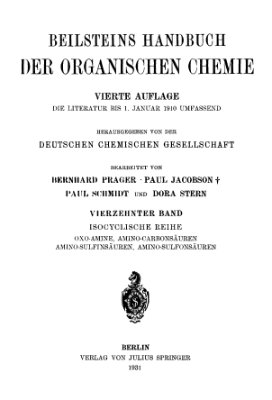Berlin: Ferlag von Julius Springer, 1931. – 950 p.
Herausgegeben von der Deutschen Chemischen Gesellschaft. Bearbeitet von Behard Prager und Paul Jacobson unter st?ndiger mitwirkung von Paul Schmidt und Dora Ste.
Beilstein's Handbuch der Organischen Chemie is a handbook of carbon compounds. This work includes data published over set periods in the scientific literature on the preparation and properties of all carbon compounds. There are six series--the Basic Series and five Supplementary Series; each series is subdivided into 27 volumes. The Chemistry Resources subscription stopped in 1992.
The classification of subject matter in each of the Supplementary Series is the same as that chosen for the 27 volumes of the Basic Series. Any particular volume of each Supplementary Series always contains the same classes of compounds as the volume of the Basic Series with the same number.
The classification of compounds into compound classes and the arrangement of the individual compounds within these classes is determined by the Beilstein System. The compounds viewed as a whole are divided into 3 major groups in the handbook:
Acyclic Compounds, Volumes 1-4
Isocyclic Compounds, Volumes 5-16
Heterocyclic Compounds, Volumes 17-27
Herausgegeben von der Deutschen Chemischen Gesellschaft. Bearbeitet von Behard Prager und Paul Jacobson unter st?ndiger mitwirkung von Paul Schmidt und Dora Ste.
Beilstein's Handbuch der Organischen Chemie is a handbook of carbon compounds. This work includes data published over set periods in the scientific literature on the preparation and properties of all carbon compounds. There are six series--the Basic Series and five Supplementary Series; each series is subdivided into 27 volumes. The Chemistry Resources subscription stopped in 1992.
The classification of subject matter in each of the Supplementary Series is the same as that chosen for the 27 volumes of the Basic Series. Any particular volume of each Supplementary Series always contains the same classes of compounds as the volume of the Basic Series with the same number.
The classification of compounds into compound classes and the arrangement of the individual compounds within these classes is determined by the Beilstein System. The compounds viewed as a whole are divided into 3 major groups in the handbook:
Acyclic Compounds, Volumes 1-4
Isocyclic Compounds, Volumes 5-16
Heterocyclic Compounds, Volumes 17-27

